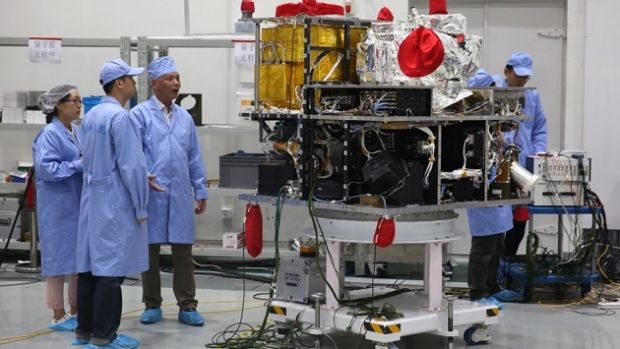Chinese scientists have established a quantum link between particles 1200 kilometres apart, smashing the previous world record of 143 kilometres.
The satellite-to-ground-station experiment is a giant leap towards establishing a worldwide quantum communication network.

Scientists expect this technology will eventually be used to develop protocols for secure cryptography, instantaneous teleportation of quantum information and to connect local quantum internet fibre networks.
The study was published on Friday in the journal Science.

"The goal of our community is to build a global quantum internet," Professor Chao-Yang Lu from the University of Science and Technology in Hefei, China, told Fairfax Media.
"Today our networks are protected by mathematics but a quantum network will be protected by the laws of physics," he said. "It will be ultra fast and ultra secure."
Professor Andrew White is director of the Australian Centre of Excellence for Engineered Quantum Systems. He said: "There is worldwide race in quantum technologies and China is the first to take it into space – and in spectacular fashion.
"They have set the standard for Europe and North America to aspire to."

Professor Tommaso Calarco from Ulm University in Germany, who was not connected to the study, said: "This is not only a major step forward scientifically but an important aspect of strategic intention by the Chinese government."
Distribution of entangled particles will provide a quantum key distribution mechanism that allows for provably secure communications, beyond which is possible now.
Such a network is still years away, however.

"It is informally known the intention is to use this for secure key distribution starting with Chinese embassies worldwide," Professor Calarco said.
He said the European Union had fallen behind China in this race.
"It is an open secret in our community that the US is investing in this area, too," Professor Calarco said.
Professor Lu said the next step in developing a global network would be to test quantum key distribution and to establish a quantum connection between China and a ground station in Vienna.
Professor Anton Zeilinger from the University of Vienna has had a long, friendly competition with the Chinese group led by his former PhD student, Jan-Wei Pan. However, they are collaborating on this project.
"This is the first distribution of [quantum] entanglement from a satellite, setting a new distance record," Professor Zeilinger told Fairfax Media.
In response to concerns about working with China on quantum cryptography, Professor Zeilinger said: "In our collaboration we have agreed in writing that everything will be published. And this works. The Chinese colleagues follow the agreement."
Professor Lu said his team publishes all its result in public and "wants to share our results with the world".
Last August the Chinese Academy of Sciences put an experimental satellite into orbit named Micius after a 5th-century BC philosopher.
On board that satellite is a quantum-enabled transmitter that can split photons – a single packet of light – into two entangled photons.
In quantum mechanics, when particles such as photons are entangled, one particle instantaneously reacts to an interaction with its pair, theoretically over an infinite distance.
Einstein dismissively called this "spooky action at a distance".
In this experiment led by Professor Pan two beams of entangled photons were fired at separate ground stations. Using what is known as a Bell test, the Chinese physicists successfully established that the photons had retained quantum entanglement.
Professor Lu said that six million entangled photon pairs were produced every second on the satellite. Almost all of these were lost in transmission, with just 1.1 photon pairs arriving on the ground every second.
Professor White from EQUS said: "One pair a second sounds bad, but if you compared optical fibres over same distance it would take 100,000 years for one photon pair to arrive."
Dr Ben Buchler at the Australian National University, who was not connected with the study, said the result was amazing.
"It's so quick; they only launched last August and they've already got results," he said.
"The immediate implication of the experiment is that these two ground stations have random chains of information that no one else has."
Professor Lu said the Pan group at Hefei University would now look to distribute quantum keys across China and then to Vienna before hopefully launching a new satellite.
"This was a first quantum science satellite for experiments. If this one is successful we will launch more in higher orbits around 1000 kilometres to increase our area of coverage."
He said the world is following, with quantum satellite development in the US, Canada, Germany, Austria and Singapore.
